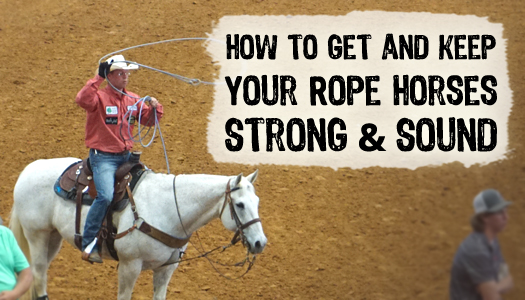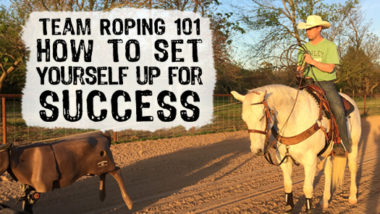For the latest episodes subscribe on iTunes or your favorite podcast app.
When was the last time you participated in a sporting event – either for fun or actual competition, without preparing your body for the amount of physical exertion required, only to endure aches and pains for several days following?
It can take a long time for our body to heal itself to the point that we feel normal again, and in situations like this, we’re more likely to incur a serious injury. Team roping is extremely physically demanding for horses, and their physical conditioning is no less important than it is for human athletes.
The stresses from running, turning, and towing a 500-pound steer around the arena is no easy task, even for the strongest and most physically fit horse.
Conditioning is the process of building up the body’s ability to produce maximum energy and strength, then maintain it over a period of time. Endurance, strength, and flexibility are all key factors to perform as an elite athlete.
In order to plan out a conditioning schedule for our rope horses, we need to know what our end goal is, including a timeline. If it’s a competition date, then we’ll have a firm target when we need our horses to be at their peak.
Evaluating our horse’s physical condition is important to determine how much time we need to get them in prime shape.
If a horse has been sitting in the pasture for several months, allowing more time to get them conditioned will set them up for long term health. On the other hand, if they have been on a short week or two vacation, the conditioning might not require as much.
When we get ready to begin our conditioning program, we want to also consider whether our horse is getting their nutrition needs met to maximize energy. Quality diet along with joint support is critical for helping our horses feel and perform their best.
Knowing our horse’s physical history can also be a key component in developing a specific program that benefits them the most. For example, some horses may just need basic exercise, whereas a different horse may need very specific conditioning for special needs or rehabilitation.
My gelding Dot Com for example sustained a severe tendon injury in October of 2016 (unrelated to roping). He was on stall rest until March of 2017 and I couldn’t begin doing any ridden exercise until June.
He’s a horse that gives 110% on every run, in the practice pen or in competition. I knew that this was a serious injury, and that if I was going to compete on him again, I would have to do everything possible to give him the best chance for a full recovery and successful return to roping.
Everyone I talked to who’d had a horse with a similar injury said their horse was never sound again. I’m not sure how many miles my wife and I hand walked him in the dark, rain and cold and mud that winter, but combined with his EquiVibe and RevitaVet light therapy, it required several hours a day of our time – just for a chance to make a comeback as a performance horse.
Once Dot Com got the all clear from our Vet. to begin a conditioning program to get back to roping, I laid out a schedule that gave us plenty of time to get him in the best shape of his life.
It wasn’t until another five months later that we would compete at our first roping back. Our very first roping we won the fast time with over 400 teams entered, and now at 19 years old, he feels better than when I first bought him nine years ago.
I knew when he got hurt that he’d never be the same, but that he had to be better if he was going to make a successful and sustainable comeback.
It’s not uncommon to try to squeak by and make some fast runs on horses that aren’t conditioned, but I’m not willing to put my horses at risk – especially after that long rehab experience and almost losing a horse of a lifetime. I never want my horse or I to go through that again if I can avoid it.
Not only does taking shortcuts expose our horse to potential risk of injury, but it could also cost us money and time rehabbing instead of competing. Outside of a major injury, over-stressing an unprepared equine body causes micro-stress that triggers subtle inflammation and causes excessive wear & tear over time, essentially shortening our horse’s careers.
Ever since DC’s return to competition, I’ve included pre-ride therapy and stretching exercises before doing any riding or roping. The purpose of this is to warm up and loosen the soft tissues and joints so they are limber prepared to extend to their full range of motion (this also results in greater stride length and speed) without compromise.
At home, typically my horses spend about 20-30 minutes on the EquiVibe vibration platform, which cause the muscles to contract and stretch while boosting circulation. This is combined with specifically targeted light therapy. RevitaVet offers some convenient, hands-free light therapy products that are effective and easy to use anywhere on your horse.
To learn more about these products visit www.RevitaVet.com and www.EquivibeTherapy.com.
After therapy is complete, I often do ‘treat stretches’ to stretch my horse’s neck and topline both laterally (sideways) and vertically (down between their legs). This loosens up the muscles and vertebra to allow for full range of motion during exercise. These stretches are excellent to counteract some of the damaging vertical tension and stiffness that many rope horses carry.
We also do some ‘back lifts’ by scratching under our horse’s belly and stretch all four legs as well. Ask your equine body worker to show you correct ways to perform these stretches and any others each specific horse will benefit from. You can also click here to download a free, printable guide with some basic instructions.
Next, outside of pre-ride therapy, it’s important to map out the combination of gaits and durations each ride will consist of.
What get’s measured, gets improved.
Conditioning our horse should involve various, gradually increasing periods of speed and time to reach our horse’s maximum physical capacity.
By alternating different gaits, we can increase or decrease our horse’s heart rate or the amount of effort they exert. This cycle of ramping up and then backing down is what works our horse’s body to strengthen their muscles, lubricate their joints, and increase their cardiovascular capacity to be high performing athletes.
Starting off slow allows our horse’s bodies to warm-up, prepare, adjust and recover more quickly from the exertion of energy on their joints and muscles.
Below is an example of a three-month conditioning period I would follow 4-5 days/week to prepare my horse for competition (you can enter the durations in the EquiTrack App on your smart phone):
- Week 1 – 10 minute walk to the left/5 min trot to the left/10 min walk to the right/5 min trot to the right/5 min walk cool down
- Week 2 – 5 min walk to the left/5 min trot to the left/2 min lope to the left/5 min walk to the right/5 min trot to the right/2 min lope to the right/5 min walk cool down
- Week 3 – 5 min walk to the left/5 min trot to the left/4 min lope to the left/5 min walk to the right/5 min trot to the right/4 min lope to the right/5 min walk cool down
- Week 4 – 5 min walk to the left/5 min trot to the left/5 min lope to the left/5 min walk to the right/5 min trot to the right/5 min lope to the right/5 min walk cool down
- Week 5 – Follow Week 4 schedule but incorporate roping sled work (Heel-O-Matic) during the walk times
- Week 6 – Follow Week 4 schedule but incorporate roping sled work during the trotting time
- Week 7 – Follow Week 4 schedule but incorporate roping sled work during the loping time
- Week 8 – Follow Week 4 schedule but incorporate roping sled work where needed
Weeks 9–12 – Later in the conditioning process we still want to spend some time walking, trotting, and loping our horse, but a majority of the exercise time will come from actually roping either the sled or live steers. For ‘exercise rides’ in between, we can follow the week four schedule.
One area often overlooked is doing a proper cool down for our horses. The amount of physical exertion our horses endure pushes their body to the limits. By treating their cool down as important as the warm up, we can allow enough time for waste products from exercise in the blood stream to circulate out of their major muscles, which helps keep their body loose, fluid and prevent soreness.
A great way to cool down our horse is by hand walking for 20 minutes after especially intense exercise or a long day of roping. Applying ice boots before walking is a great way to draw out the heat in their legs and reduce the chance of any inflammation occurring.
On days you don’t rope, spend time just riding or especially on days after roping – giving them some rest and turnout to allow their body to refresh. Typically, I will be roping 1-3 days a week, and exercising 1-3 days a week, with at least one full day of turnout and rest, although two rest days is even better for a high-performing finished rope horse.
The number of live steers you rope will likely be determined by the age or experience of your horse. It’s important to get in practice to keep our own roping skills sharp, but we also need to ensure we’re not over-doing it for our horses. If we sacrifice them for our own gain, we’re not really getting ahead.
Our horse is the one of the most important investments we have in team roping, and by ensuring they always feel their best puts the odds for winning more in our favor. Without them, we’re on foot. Our horses help us fulfill our dreams, and we get out of them what we put in – so it only makes sense to go the extra mile to prepare and care for them. Their performance and long-term health is really dependent on their daily care and conditioning. Providing that at the highest level is a small price to pay for all they give back to us.
If you’d like more support beyond what I shared today, click here to learn about video coaching and be sure you’re subscribed to receive roping tips here at CraigSmithTeamRoping.com.


